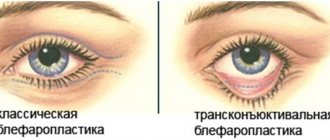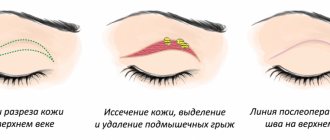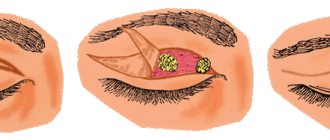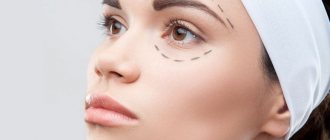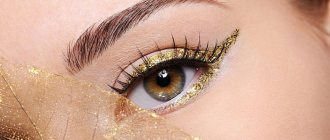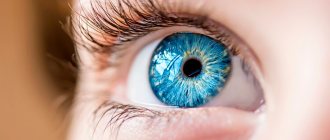Over the years, the skin tends to lose its freshness and healthy appearance. Often the age of the owner is noticeable in the eyes. Expression wrinkles located in the area around the eyes contribute to the formation of deeper wrinkles. Unpleasant emotions among the fair sex are caused by the presence of sagging skin on the eyelids. This defect gives the appearance a tired look, making the look frowning and dissatisfied. In particular, excess skin on the eyelids negatively affects vision. Today, plastic surgery called blepharoplasty of the eyelids will help correct these shortcomings. However, like any surgical intervention, this operation has certain contraindications and possible unpleasant consequences.
What is blepharoplasty and its types
Blepharoplasty is a surgical procedure that allows you to correct the shape of the eyelid by excision of excess skin, removal of fat deposits and tightening of muscles. Thanks to this operation, patients completely forget about drooping eyelids, acquiring an open look.
It is worth noting that this type of surgery is in demand among patients of different age categories. Middle-aged people, thanks to blepharopastics, cope with the emerging age-related changes and “shed” ten years at a time. And young patients often turn to specialists to slightly correct the structure of their eyelids.
The doctor independently determines what the patient needs, based on his wishes. There are four types of such operations in total, each of which we will analyze separately.
Lower eyelid surgery is suitable for those patients who are bothered by so-called “bags” under the eyes or deep folds in this area. It also helps get rid of bruises, swelling and other imperfections that make the look heavier.
This type is performed in three ways:
- Classic look - a small incision is made along the edge of the eyelash growth, which after the rehabilitation period becomes almost invisible.
- Laser type - this method leaves virtually no traces and reduces tissue restoration time to a minimum. Even the swelling that appears after the operation disappears in the coming days. The patient himself does not experience any discomfort either during or after the operation.
- Transconjunctival type - such operations are performed using small punctures on the inside of the eyelid. The big advantage of this type is the complete absence of stitches and quick rehabilitation. However, the doctor will determine for himself whether this method is suitable for you or not.
Upper eyelid surgery is suitable for those who want to correct age-related changes, sagging skin and regain their normal viewing angle. Here, not only additional excision of excess skin is performed, but also the muscle of the eyelid itself is tightened to consolidate the result.
In addition, there are also circular and transconjunctival blepharoplasty. The first type involves simultaneous correction of the shape of both the upper and lower eyelids, and the second type is carried out for young patients who do not yet have excess skin and wrinkles, but have excess fat in the eyelid area.
Reviews
Karina, 44 years old
I had trouble with my eyes; excess skin appeared on the upper eyelid, which literally poisoned my life. It got to the point where it became difficult for me to open my eyes in the morning. I flatly refused the operation that would help me get rid of this thing. I was very afraid of anesthesia, I had read too much about it.
I was browsing through the forums and came across a discussion about eyelid Thermage. I contacted a famous cosmetology clinic in Moscow that performs these procedures. It wasn't exactly cheap and required several procedures. But I really liked it, I don’t feel sorry for myself. First of all, it's very fast. He came on time, they processed you, and he left. It’s the same with my busyness. It’s hard for me to imagine that I’ll undergo surgery and then I don’t know what will happen. After a couple of months, the eyelids returned to almost normal. Let's see how long the effect lasts.
How the operation is performed
To begin with, the patient is examined by a doctor. He prescribes the necessary tests to make sure there are no contraindications. The examination may take about three days, after which the day of the operation itself arrives.
The duration of the procedure depends on the type of surgery. But on average it takes from 30 minutes to two hours. In this case, the doctor can use both general anesthesia and local anesthesia. The rehabilitation period lasts approximately three days, after which the patient can go home.
If the surgeon applied stitches, they are removed on the fourth or fifth day. Bruises and swelling disappear after 10 days, and after two weeks the patient is allowed to wear light makeup. The final result appears after a couple of months, when swelling and inflammatory processes in the tissues completely disappear. But it is still worth noting that the effect and all risks depend solely on the characteristics of the body. Therefore, it is important to conduct a thorough examination before surgery.
Possible complications
What types of complications can occur after blepharoplasty? Like any treatment method, blepharoplasty is caused by the following types of complications:
- Swelling.
Swelling of the eyelids after surgery for 7-10 days is normal. If swelling does not subside for more than 10 days, then this is a serious complication. After all, puffiness of the eyes directly affects vision. - Hematomas.
The occurrence of hematomas is caused by the accumulation of blood near damaged vessels. The development of bleeding at any stage of rehabilitation cannot be ruled out. - An excessively inverted eyelid can cause the eye to be unable to close completely. This phenomenon occurs when an inexperienced doctor removes an excessive amount of skin.
- Infectious infections. If you do not follow simple hygiene standards, then various kinds of bacteria enter through the wound, causing infections. This leads to serious consequences that can result in the loss of your eyes.
- Seams coming apart. If the sutures were placed incorrectly, their divergence is possible. In this case, it is necessary to immediately apply new ones to prevent scar formation.
Contraindications
With a question about contraindications, we turned to the manager of the Institute of Plastic Surgery on Tsvetnoy Boulevard in Moscow, Ksenia Delnik . According to her, tests are required before any surgical intervention. This will allow doctors to exclude the presence of serious diseases and existing risks to the patient’s health.
Expert comment:
“There is a so-called hospital complex, it is familiar to all laboratories and any clinic. There is a certain range of tests that, according to the protocol for any operation, must be taken so that the entire operating team understands what is happening in the patient’s body.”
According to her, based on the results of the examination, doctors must make a conclusion about the presence of any infections and inflammatory processes, determine the level of hemoglobin, pay attention to blood clotting and the presence of chronic diseases. If necessary, additional tests are prescribed from other specialists, who approve the operation and eliminate all existing risks. Delnik emphasized that any patient, regardless of age, must undergo an electrocardiography procedure.
The specialist denied the information that everyone who wants to undergo plastic surgery is sent for a forced consultation with a psychiatrist. As it turned out, this is done only in doubtful cases when the patient does not care at all about the aesthetic part of his appearance.
Delnik spoke about the existing contraindications with which the operation is strictly prohibited. Among them:
- pregnancy;
- lactation period;
- oncological diseases;
- any chronic diseases in acute form.
Patients with high blood pressure and diabetes are at risk. Therefore, after reviewing the test results, the surgeon himself decides whether blepharoplasty can be performed on such a patient.
How to choose the right specialist
If everything is clear with blepharoplasty techniques and contraindications, then how can you choose a competent specialist who will do the job in the best possible way and will not harm your health? According to Ksenia Delnik, in our time, the patient has every right to request from the doctor all the necessary documents confirming the availability of medical education and certificates in plastic surgery. She recommended paying special attention to certificates so as not to run into a surgeon who takes on any work without having any skills in this area.
Expert advice
“There is a requirement from Rospotrebnadzor that on the websites of clinics that provide plastic surgery services, each surgeon has these documents freely available in the “Education” column,” stated FAN’s interlocutor.
The specialist answered a question about the eyelid lifting procedure using laser treatment, which is gaining popularity among cosmetologists. According to her, the laser literally “evaporates” the skin, provoking the production of its own collagen and elastane. It is these substances that help thicken the skin in problem areas. However, the expert explained that cosmetology is still unable to correct age-related changes in the eyelids.
Important
“If the patient already has a sufficient amount of excess skin in the eyelid area, then it is impossible to correct it cosmetically so that the result lasts for at least six months. There is no such technique. Cosmetology will not remove excess skin, but it can definitely prolong youth and correct mild age-related changes,” the specialist explained.
Delnik emphasized that procedures from a cosmetologist will not be able to tighten the eyelid muscle or rid the patient of excess skin that interferes with the viewing angle. Therefore, if there are irreversible age-related changes, you should contact not cosmetologists, but qualified plastic surgeons.
Indications for use
Turn to non-surgical treatment through injection correction in the case of:
- long-term signs of fatigue, stress, impaired metabolism (dark circles, bags);
- the appearance of the first wrinkles (crow’s feet, “mesh” on the lower eyelid);
- excessive thinning of the skin;
- drooping eyelids;
- strong expression of the nasolacrimal groove;
- decrease in turgor.

